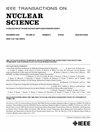多模态中子层析成像的迭代重建
IF 1.9
3区 工程技术
Q3 ENGINEERING, ELECTRICAL & ELECTRONIC
引用次数: 0
摘要
我们描述了一个统一的框架,用于基于模型的多模态中子透射、氢散射和诱导裂变图像的迭代三维重建,这些图像来自使用$\ mathm {14.1~\!\!\text{-}\text{MeV}}$中子和相关的粒子成像(API)技术。该框架是为了便于在具有挑战性的现场部署场景中使用而开发的,其核心是基于物理的系统模型和同步迭代重建技术(SIRT)的总变化(TV)约束实施。为了解决统计加权最小二乘(WLS)问题,SIRT算法使用有序子集和Nesterov动量进行加速,我们为此导出了控制Lipschitz常数的近最优值。该方法能够重建图像,与获取的数据相比具有高分辨率,并且对有限的统计数据和有限数量的投影角度都具有鲁棒性。此外,该框架的速度足够快,具有实用性。举例说明了在低辐射剂量下对高原子序数材料进行快中子成像的能力,以及多模态中子成像识别关键材料的优势。本文章由计算机程序翻译,如有差异,请以英文原文为准。
Iterative Reconstruction for Multimodal Neutron Tomography
We describe a unified framework for model-based iterative 3-D reconstruction of multimodal neutron transmission, hydrogen-scatter, and induced-fission images from low resolution data recorded using $\mathrm {14.1~\!\!\text {-}\text{MeV} }$ neutrons and the associated-particle imaging (API) technique. The framework, which was developed to facilitate use in challenging field-deployment scenarios, is centered around physics-based system models and a total variation (TV) constrained implementation of the simultaneous iterative reconstruction technique (SIRT). Modified to solve a statistically weighted least squares (WLS) problem, the SIRT algorithm is accelerated using ordered subsets and Nesterov’s momentum for which we derive a near-optimal value of the governing Lipschitz constant. The approach enables the reconstruction of images that are high resolution compared to the acquired data and is robust to both limited statistics and a limited number of projection angles. Moreover, the framework is fast enough to be practical. Example images are provided that demonstrate both the ability to perform fast-neutron imaging of high-atomic-number materials with low radiation dose and the benefit of multimodal neutron imaging to identify key materials.
求助全文
通过发布文献求助,成功后即可免费获取论文全文。
去求助
来源期刊

IEEE Transactions on Nuclear Science
工程技术-工程:电子与电气
CiteScore
3.70
自引率
27.80%
发文量
314
审稿时长
6.2 months
期刊介绍:
The IEEE Transactions on Nuclear Science is a publication of the IEEE Nuclear and Plasma Sciences Society. It is viewed as the primary source of technical information in many of the areas it covers. As judged by JCR impact factor, TNS consistently ranks in the top five journals in the category of Nuclear Science & Technology. It has one of the higher immediacy indices, indicating that the information it publishes is viewed as timely, and has a relatively long citation half-life, indicating that the published information also is viewed as valuable for a number of years.
The IEEE Transactions on Nuclear Science is published bimonthly. Its scope includes all aspects of the theory and application of nuclear science and engineering. It focuses on instrumentation for the detection and measurement of ionizing radiation; particle accelerators and their controls; nuclear medicine and its application; effects of radiation on materials, components, and systems; reactor instrumentation and controls; and measurement of radiation in space.
 求助内容:
求助内容: 应助结果提醒方式:
应助结果提醒方式:


